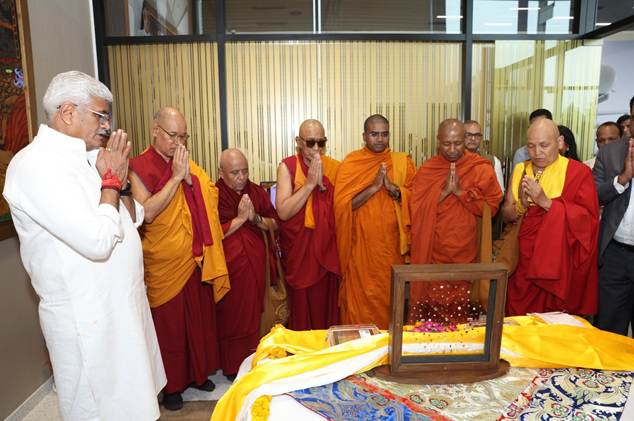Piprahwa Relics

- 02 Aug 2025
In News:
The recent return of the sacred Piprahwa relics of Lord Buddha to India marks a landmark moment in India’s cultural diplomacy, heritage preservation, and spiritual history. Orchestrated by the Ministry of Culture in partnership with the Godrej Industries Group, this event prevented the relics’ auction in Hong Kong (May 2025) and instead restored them to their rightful home. For India, the land where the Buddha attained enlightenment and preached, this repatriation is more than a matter of archaeology—it reaffirms India’s role as the civilizational custodian of global heritage.
What are the Piprahwa Relics?
- Association: Believed to be the mortal remains of Lord Buddha, enshrined by the Sakya clan (his kinsmen) in the 3rd century BCE.
- Discovery: Excavated in 1898 by William Claxton Peppé, a British civil engineer and estate manager, from a stupa at Piprahwa, Uttar Pradesh, located just south of Lumbini (Buddha’s birthplace, now in Nepal).
- Contents:
- Bone fragments of the Buddha
- Caskets: soapstone, crystal, and sandstone coffer
- Offerings: gold ornaments, gemstones, and other ritual objects
- Inscription: A Brahmi script engraving on one of the caskets confirmed the relics’ identity, noting they were deposited by the Sakya clan.
Historical Journey of the Relics
- Colonial Appropriation (1898–1899)
- Following their discovery, the British Crown claimed the artefacts under the Indian Treasure Trove Act, 1878.
- The bone and ash relics were gifted to King Chulalongkorn of Siam (Thailand), reflecting colonial practices of cultural transfer.
- The majority of the remaining relics were placed in the Indian Museum, Kolkata (1899).
- Legal Protection
- Classified as ‘AA’ antiquities under Indian law, these relics cannot be sold, exported, or removed—underscoring their sacred and national significance.
- Attempted Auction in 2025
- The relics resurfaced in Hong Kong for an intended auction.
- Through timely diplomatic and legal intervention, supported by public-private partnership with the Godrej Group, the Ministry of Culture secured their return.
Significance of the Repatriation
1. Spiritual and Cultural Significance
- Buddhism, which spread from India across Asia, regards relics of the Buddha as sacred embodiments of peace, compassion, and enlightenment.
- The return reaffirms India as the spiritual homeland of Buddhism, strengthening cultural linkages with Buddhist-majority nations like Thailand, Myanmar, Japan, and Sri Lanka.
2. Archaeological and Historical Importance
- Piprahwa is one of the earliest archaeologically verified stupa sites.
- The discovery provides rare material evidence of Buddhist practices of relic veneration, confirming textual accounts in Buddhist scriptures.
3. Diplomatic and Soft Power Dimensions
- The move highlights cultural diplomacy as a tool of India’s foreign policy.
- India positions itself as a global guardian of Buddhist heritage, enhancing ties with Southeast Asian nations where Buddhism is deeply rooted.
4. Model of Public–Private Partnership
- The collaboration between the Government of India and the Godrej Industries Group sets a precedent for safeguarding heritage.
- It reflects how corporate social responsibility (CSR) can extend beyond business to civilizational legacy.
